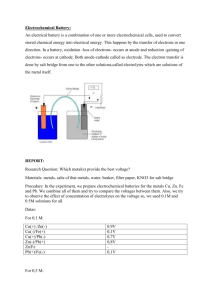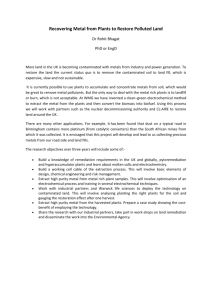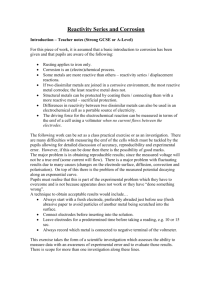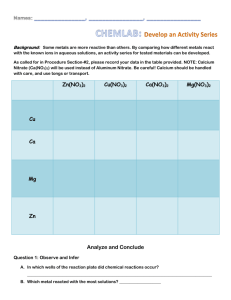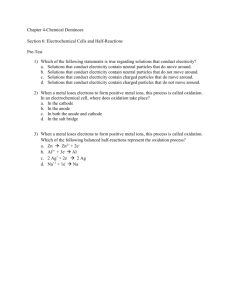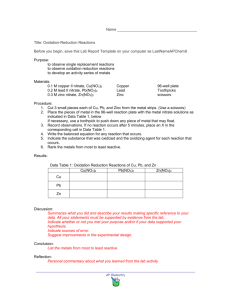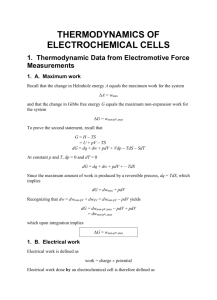1 Oxidation-Reduction Reactions and Batteries Objective: During
advertisement
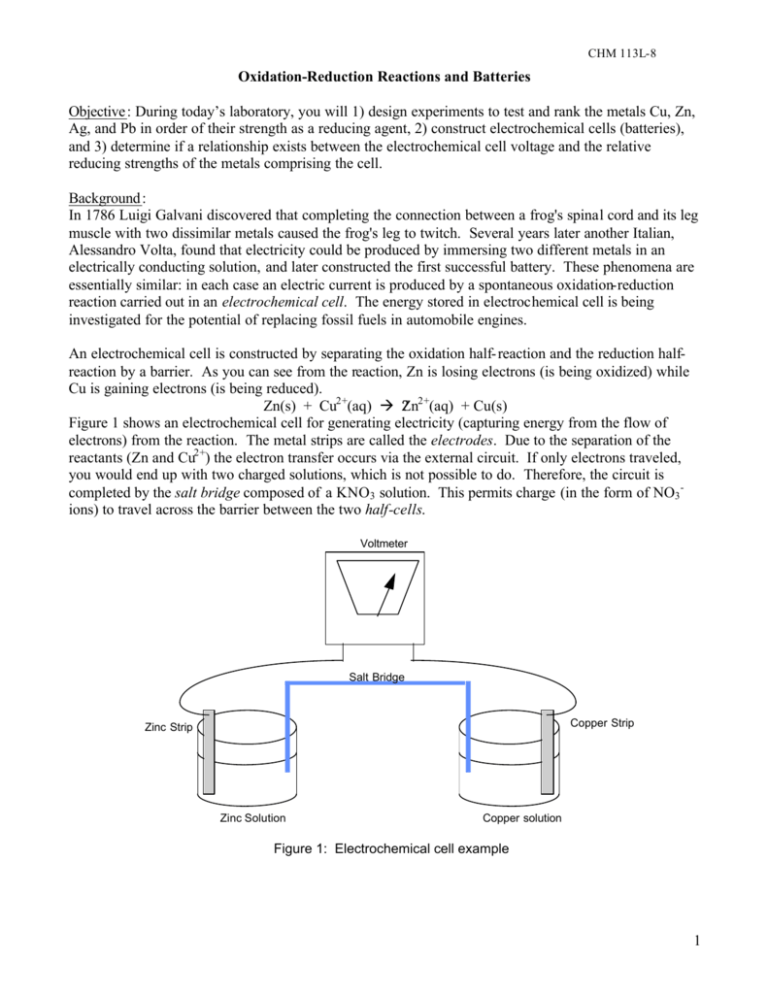
CHM 113L-8 Oxidation-Reduction Reactions and Batteries Objective : During today’s laboratory, you will 1) design experiments to test and rank the metals Cu, Zn, Ag, and Pb in order of their strength as a reducing agent, 2) construct electrochemical cells (batteries), and 3) determine if a relationship exists between the electrochemical cell voltage and the relative reducing strengths of the metals comprising the cell. Background : In 1786 Luigi Galvani discovered that completing the connection between a frog's spinal cord and its leg muscle with two dissimilar metals caused the frog's leg to twitch. Several years later another Italian, Alessandro Volta, found that electricity could be produced by immersing two different metals in an electrically conducting solution, and later constructed the first successful battery. These phenomena are essentially similar: in each case an electric current is produced by a spontaneous oxidation-reduction reaction carried out in an electrochemical cell. The energy stored in electrochemical cell is being investigated for the potential of replacing fossil fuels in automobile engines. An electrochemical cell is constructed by separating the oxidation half- reaction and the reduction halfreaction by a barrier. As you can see from the reaction, Zn is losing electrons (is being oxidized) while Cu is gaining electrons (is being reduced). Zn(s) + Cu2+(aq) à ?Zn2+(aq) + Cu(s) Figure 1 shows an electrochemical cell for generating electricity (capturing energy from the flow of electrons) from the reaction. The metal strips are called the electrodes. Due to the separation of the reactants (Zn and Cu2+) the electron transfer occurs via the external circuit. If only electrons traveled, you would end up with two charged solutions, which is not possible to do. Therefore, the circuit is completed by the salt bridge composed of a KNO3 solution. This permits charge (in the form of NO3 ions) to travel across the barrier between the two half-cells. Voltmeter Salt Bridge Copper Strip Zinc Strip Zinc Solution Copper solution Figure 1: Electrochemical cell example 1 CHM 113L-8 Procedure: I. Chemical Reactivity of Cu, Zn, Ag, and Pb A. Design experiments to determine the relative reducing strengths of Cu, Zn, Ag, and Pb. 1. Each of the solutions contains a cation that can be reduced by a sufficiently strong reducing agent 2. Each of the pure metals can be oxidized by a sufficiently strong oxidizing agent. 3. The following reagents will be available to you: metals: Cu, Zn, Ag, and Pb (2 cm strips or wires) solutions: 0.1 M Cu(NO3 )2 , 0.1 M Zn(NO3 )2 , 0.1 M AgNO3 , 0.1 M Pb(NO3 )2 , 1 M HCl. B. Carry out the experiments you designed in part A. 1. Carry out all reactions in a plastic wellplate. 2. Remove any coatings from the metal strips with sandpaper or a Scotchbrite pad. Be sure to place only clean metal strips in the solutions. 3. Be sure to record your observations. Some reactions may not be noticeable until after one or two minutes. Caution: Solutions containing lead are poisonous. Silver nitrate solutions will stain skin – AgS is black (where does the sulfur come from?). II. Cell Voltages and Metal Reactivities A. Set up the Zn/Zn2+, Cu/Cu2+ electrochemical cell shown in Fig. 1. 1. Use 0.1 M Cu(NO3 )2 , 0.1 M Zn(NO3 )2 , Cu, and Zn. The metal strips must be dry. 2. To make the salt bridge cut a piece of filter paper to about 1²x1², fold it lengthwise, and wet it with a 1 M KNO3 solution. 3. If the voltmeter reading is negative then reverse the connections to the electrodes to obtain a positive reading. 4. Record the cell voltage. Also determine at which electrode the electrons are leaving the electrochemical cell and the electrode through which the electrons enter the cell. (The voltmeter displays a positive reading when electrons flow into the "- " or "COMMON" terminal of the meter and out the "+" or "VOLTS" terminal.) B. Repeat step 1 for all the remaining combinations of half-cells. (There are a total of 6 combinations of half-cells.) Write Up Complete the write up sheet posted at the web page. Questions : 1. Rank Cu, Zn, Ag, and Pb in order of their strengths as reducing agents and write the balanced chemical equation for any reaction you observe. 2. Discuss the relationships among the voltages of your electrochemical cells. Can you find any correlation between the cell voltages and the reducing strengths of the two metals comprising the cell? 3. Compare the voltages you measured to the value calculated from tables in your textbook. If they do not agree, be sure to discuss why. References: Brown, T. L., LeMay H. E., and Bursten B. E. Chemistry: The Central Science, 8th ed. Prentice Hall, 2000. 2
